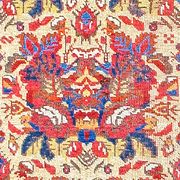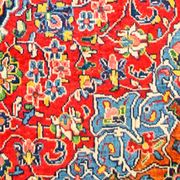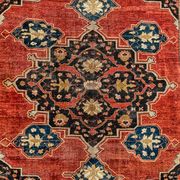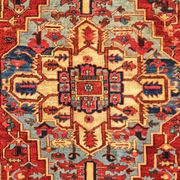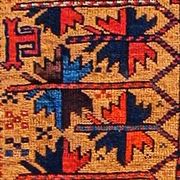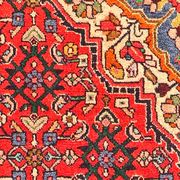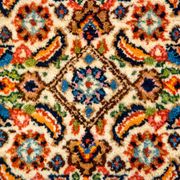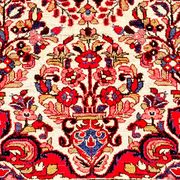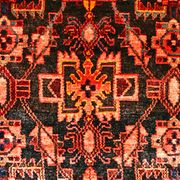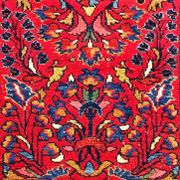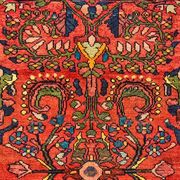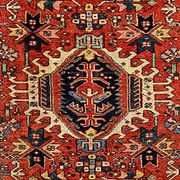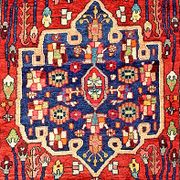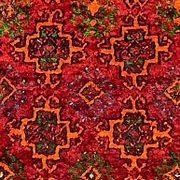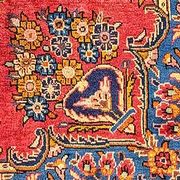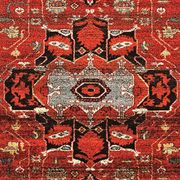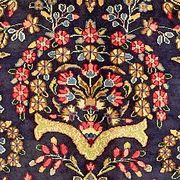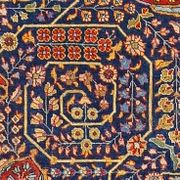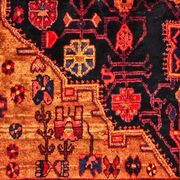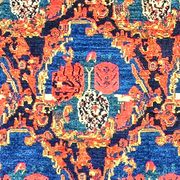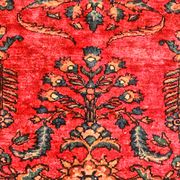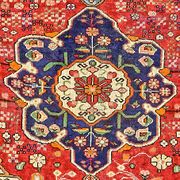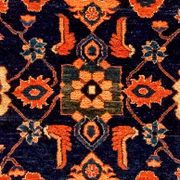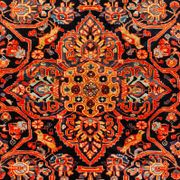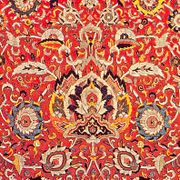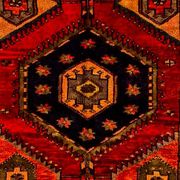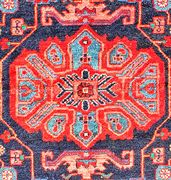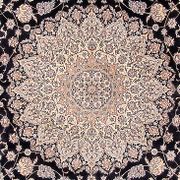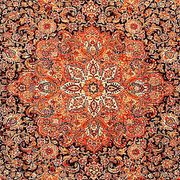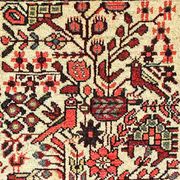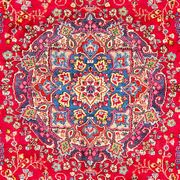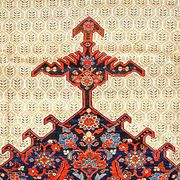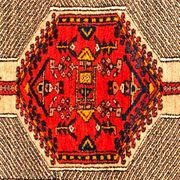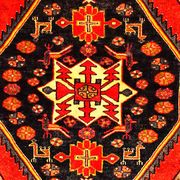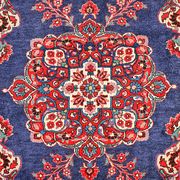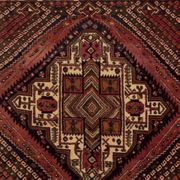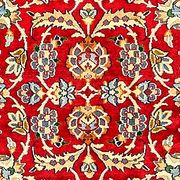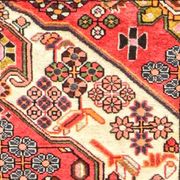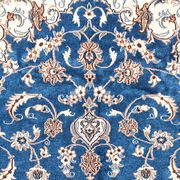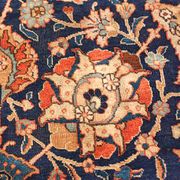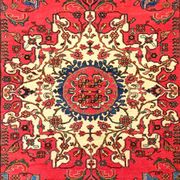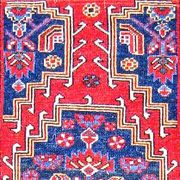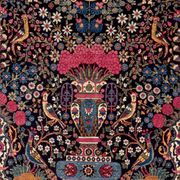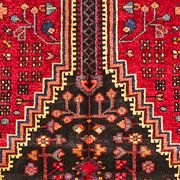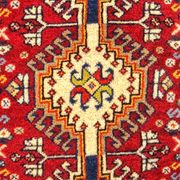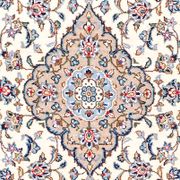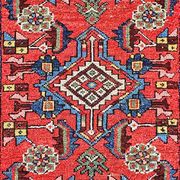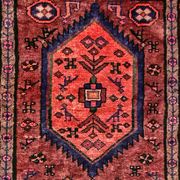Persian Carpet
| Persian Carpet | |
|---|---|
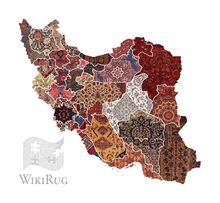 | |
| General information | |
| Name | Persian Carpet Rug |
| Original name | فرش ایران |
| Alternative name(s) | Persian Rug |
| Origin | |
| Category | Village, |
| Technical information | |
| Common designs | Afshan, Boteh, Farangi Gul, Herati, Vase, Hunting, Geometric, Islimi, Lattice, Medallion, Mihrab, Shah Abbasi, Tree, Tribal, Vagireh |
| Common colors | Red, Ivory, Beige, Blue, Yellow |
| Dyeing method | Natural, Synthetic |
| Pile material | Wool |
| Foundation material | Cotton, Silk |
| Knot type | Symmetrical (Turkish), Asymmetrical (Persian) |
Persian Carpet is distinguished by its complex and calligraphic nature, emphasizing the design and the line. A curvilinear or floral design is most closely associated with a Persian rug, although geometric designs are used as well. The major production centers can be found in Northwest Persia, Western Persia, Southwestern Persia, Central Persia, Southern Persia, and Eastern Persia. Named after the village, town or district where the piece was woven or by the weaving tribe, each Persian carpet has attributes specific to a geographic region or tribe.
Persian rugs from Tabriz is sought after for its exquisite craftsmanship. Very classical in appearance, the central medallion is the layout most frequently used. Kerman is known for its vase technique and vase design. A vase design on a Persian carpet is characterized by an ascending directional layout. Pairs of long stems emerge from elegant vases, intersecting at regular intervals, creating a sort of latticework. A Kashan Persian rug is known for a central medallion layout with arabesques, palmettos, leaves, and other plants, interspersed with small birds or animals. A Mashad Persian rug, made using the asymmetrical knot, often features a round or elongated medallion design that is embellished with pendants and floral elements. Every region brings its own unique characteristics to the art of Persian carpet weaving.
History
Iran (Persia) is a country located in the Middle East in the southwestern region of Asia.
Achaemenid Empire
Persia is an ancient country with a rich culture of art and science dating back to the Achaemenid Empire (r. 550-330 BCE) founded by Cyrus the Great (r. 559- 530 BCE). Some examples of great architecture and art remain from that period in Fars Province. The Persian Empire historically controlled India in the east and Egypt and Greece in the west.[1]
Sasanian Empire
The Sasanian Empire (r. 224-651 CE) overthrew Greek culture and influence in Persia, and reestablished the advancement of Persian Zoroastrian civilization by building cities, palaces, and roads, and manufacturing textiles. Its location on the Silk Road allowed Persia to purchase and broker the trade of silk from China to the West. This was a period of prosperity for Persia. Its silk garments and textiles were admired as an art form by the Greeks and Romans. They have unique designs featuring real and imaginary animals, birds, and other motifs, and are today preserved in museums around the world. The Sasanian era is also credited with textiles woven with metallic threads. Historical documents cite the Baharestan Palace Carpet, also known as the “Spring of Khosrow Carpet,” which was made for the residence of King Khosrow I during his reign (531-579 CE). This ancient carpet was a beautiful and dazzling expression of power, depicting a Garden design with trees, flowers, plants, and fruits. It was a flatwoven carpet made of wool and silk, with gold and silver threads, precious jewels, and pearls incorporated into the design. During the winter, this palace-size carpet was used for royal celebrations to give the impression of an outdoor spring garden. In the course of the Arab conquest of Persia, this carpet was cut into fragments and looted.
In October 2011 an example of Sasanian Rugs appeared in the market, at Christie’s London auction house. This rug has a pile field with two sections of tapestry technique woven on the upper and lower portions. This is the first time that a Sasanian pile rug has been seen in public. It was woven with the Persian (asymmetric) knot and a wool pile. The tapestry border has a design featuring a row of guardian lions, symbolic of power. A similar design is also seen in the guard border of the Pazryk Carpet, the oldest pile carpet in the world, which is preserved in the State Hermitage Museum in St. Petersburg, Russia. The protective lions were also a symbol of strength during the Assyrian Empire and appeared as statues in and around the palaces at the time.[2]
Early Islamic
In 651 CE the Arabs overthrew the last Sasanian king,Yazdegerd III (r. 632-651), establishing Islamic rule in Persia. The Arabs destroyed the advancement of Zoroastrian art, culture, and scholarship, which was the Persian spiritual foundation for more than a millennium. Over the centuries foreign invaders such as the Seljuks, Mongols, and Timurids took control of Persia.[3]
Safavid Empire
After centuries of foreign occupation, Persia was unified and became independent with the establishment of the Safavid Empire (r. i50i-i722).The Safavids continued Islamic rule and introduced Shia Islam as the official Persian religion throughout the empire. The Safavids recognized Persia’s history in art, culture, science, and literature. The kingdom had great interest in advancing Persian arts and culture and opened a school for art in the city of Tabriz. Later, during the reign of Shah Abbas (r. 1588-1629), the kingdom opened a second school in the capital of Isfahan. Tile and ceramic painting, metalwork, silk and velvet manufacturing, and carpet weaving were taught at these academies. The Safavid period is known as the golden age of Persian art.
Safavid Carpets produced during this era were among the finest woven in the world. Noteworthy styles made were the exceptional high-grade silk pile rugs. The famous Polonaise Carpets made during this period featured silk pile of superb quality with a metallic brocade technique. Safavid artists introduced the medallion and Ardabil designs, Hunting patterns, and poetic inscriptions. The most famous designs from this period have palmettes, leaves, and vines in the field and borders of the carpets; this is named Shah Abbas after the ruler. Carpet weaving was mostly done in Isfahan and Kashan under the strict supervision of the Safavid Court, which monitored the materials, colors, and designs used. The carpet industry grew dramatically and the major cities of Herat, Kerman, Mashad, and Tabriz also produced carpets.
During the Safavid era flatweaves of superb quality and design execution were made with a fine silk foundation and gold and silver metallic thread for the pattern wefts. These rugs, with inscriptions reading “Pad-shah” (king) giving the carpet its name, Padishah, were made exclusively for royalty in Persia. Padishah and other flatweaves from that period were made on a limited scale. They are rare and can be found in museums and private collections worldwide.
The Safavids became famous by commercializing the carpet weaving industry. Safavid carpets were in high demand by the monarchs and nobility of the West for their palaces and residences. This art form had a large economic impact on the Safavid Kingdom.
The sixteenth century was a high point of Oriental carpet production. During this period fine Court carpets were produced by the Safavid Persians, Ottoman Turks, Mamluk Egyptians, and the Mughal Indians led by Akbar the Great. Today these carpets are highly coveted and are placed in respected museums worldwide.[4]
Qajar Empire
In 1794 the Qajar Kingdom took control, under the rule of Agha Mohammad Khan Qajar (1794— 1797), reunifying Persia after the earlier fall of the Safavid Dynasty. The carpet industry slowed during the first half of Qajar era but rebounded in the last quarter of the nineteenth century with the growing demand worldwide for floor coverings. In Kashan, Kerman, Khorasan, Kurdistan, Sulatababad, Tabriz, and other locations, Persia began to produce carpets primarily for foreign export. During the Qajar period, carpet production was independent from the government, unlike in Safavid times, and great master weavers emerged throughout Persia, such as Amoghli, Haj Jalili, Mohtashem, and Saber, among many others. Their carpets are valuable in the antique market today.
During the early nineteenth century Persian tribal folk art rugs were introduced to the West, which began to desire this type of design. Some notable Persian tribal and nomadic rugs were woven by Caucasians, Turkomans, Baluchs, Kurds, Loris, Bakhtiaris, Qashqais, and Afshars. Turning points came for the Qajar Kingdom with the Treaties of Gulistan (1813) and Turkmanchai (1828), which forced the Qajars to surrender the Caucasus region to the Tsarist Empire of Russia and lose some of the most talented and artistic tribal rug weavers in the world. In 1881 Turkmenistan, Tajikistan, and Uzbekistan were seized by Russia under the Treaty of Akhal, with the Qajars again losing land and the important, beautiful rugs produced by nomadic and tribal artisans. Today some of the tribal folk art rugs made in these areas are considered very important in the antique market.[5]
Pahlavi Dynasty
In 1921 Reza Khan (r. 1925-1941) seized control of the country, dissolving any remains of the Qajar ruling class and establishing the Pahlavi Dynasty in Persia. Under Pahlavi rule the country began to modernize, with attention given to railroad and infra-structure development, education, and advancement in industry. In 1935 Reza Shah Pahlavi requested foreign nations to address his country as Iran rather than Persia to usher in a new era. Reza Shah gave special attention to the carpet weaving industry, promoting loans for weavers to upgrade carpet production. He supported the switch from wooden looms to those made of iron and the import of high- quality wool and silk for weaving. The shah established Sherkat Farsh, which produced carpets with natural dyes and high-quality wool under the supervision of government officials. After World War II carpet production was at its highest level ever, with carpets as the second-leading Iranian export after oil. Weavers in Kashan, Isfahan, Mashad, Nain, Tabriz, and other areas made the finest-quality carpets during this period.[6]
Islamic Revolution
The strong market demand for carpets continued for decades up until the Islamic Revolution in 1979. After the revolution foreign export of carpets was restricted under government rules and weaving production was greatly reduced throughout Iran. Carpet importers worldwide adjusted and successfully began to order and imitate traditional Persian designs from India, Pakistan, China, and other weaving countries. In the last two decades, the Iranian government and weavers have tried hard to regain their place in the world market but have had difficulties competing with the lower labor costs of other countries.
Today in Iran, traditional designs are no longer exclusive to one town or city, in contrast to the past, which causes confusion as to a carpet’s origin. Iranian weavers openly make carpets of various designs and qualities throughout the country to meet world market demand.[7]
Styles
Rugs may be classified according to socioeconomic modes of production as court or atelier rugs, factory or commercial rugs, cottage industry or village rugs, and nomadic or tribal rugs. All of these modes of production have been used in Persia. Although the earliest rugs of Persia were probably nomadic, the oldest extant complete rugs are those of the court.[8]
Materials
Foundation and Pile
The materials from which rugs are made, named in order of the ratio in which they are used, are wool, goats' hair, camels' hair, cotton, silk, and hemp.[9]
Techniques and structures
Color and dyeing
Originally, dyeing of rug wools was practiced by weavers. In persian with a long tradition of rug weaving, dyeing developed as an independent and skilled craft.[10] Although today dyeing method in persian rug classified to natural and synthetic.
Motifs and Designs
The overall composition of decorative elements of a rug. The ornamental aspect of a rug or textile consisting of lines and/or colored areas. These make up images or patterns intended to be visually pleasing or symbolic. A design often consists of an arrangement of motifs.[11]
Weaving techniques
Persian rugs are hand-woven with Both Turkish (symmetrical) and Persian (asymmetrical) knots.
Gallery
See also
| Search for Persian Carpet on Wikipedia. |
References
Bibliography
- Abraham Levi Moheban. 2015. The Encyclopedia of Antique Carpets: Twenty-Five Centuries of Weaving. NewYork: Princeton Architectural Press.
- George Griffin Lewis. 1920. The Practical Book of Oriental Rugs. Philadelphia: Lippincott.
- Peter F. Stone. 2013. Oriental Rugs: An Illustrated Lexicon of Motifs, Materials, and Origins. North Clarendon :Tuttle.




